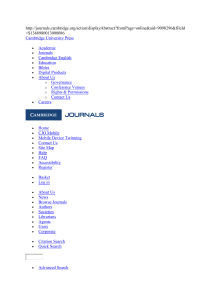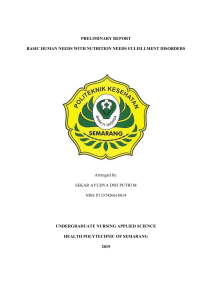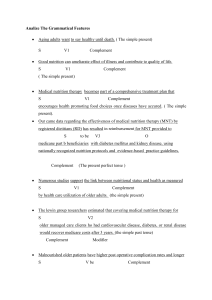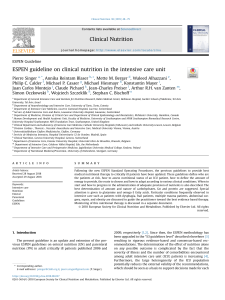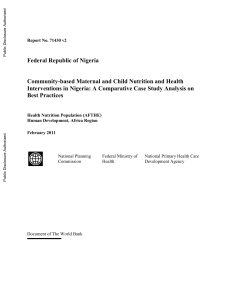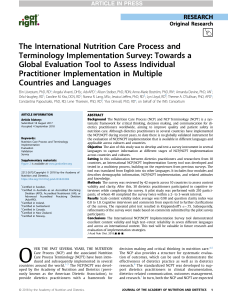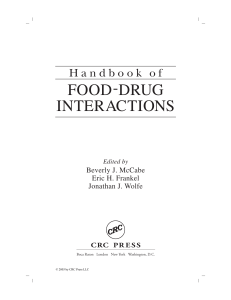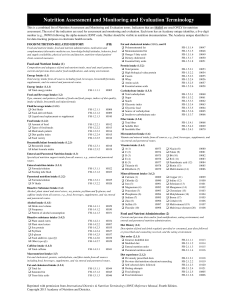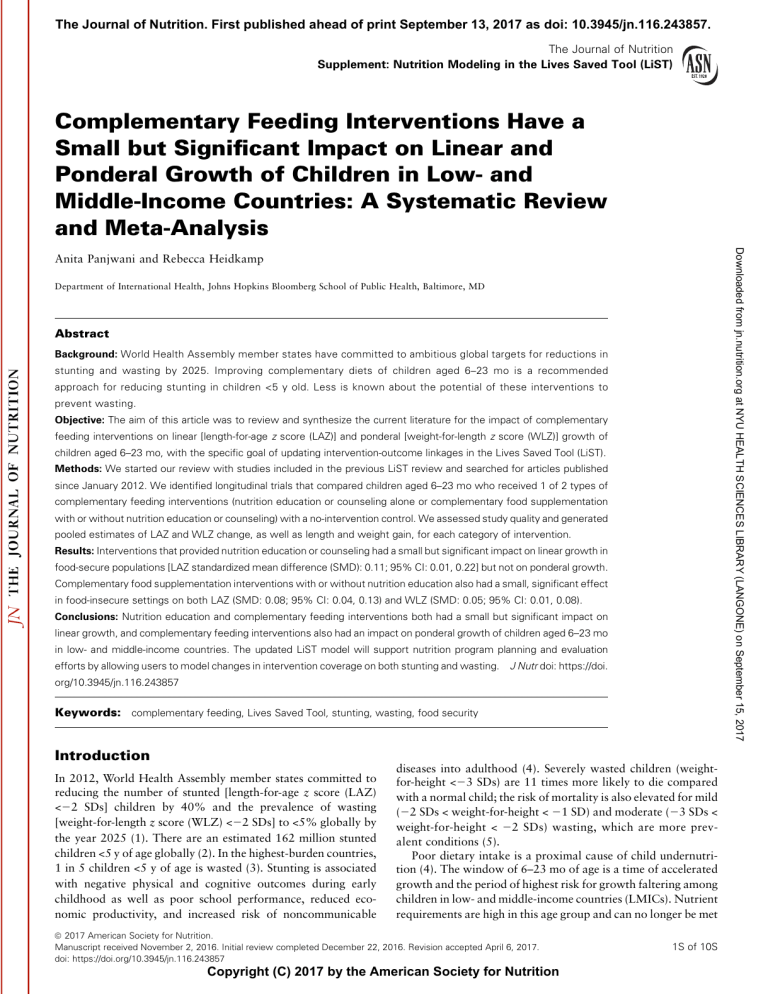
The Journal of Nutrition. First published ahead of print September 13, 2017 as doi: 10.3945/jn.116.243857. The Journal of Nutrition Supplement: Nutrition Modeling in the Lives Saved Tool (LiST) Complementary Feeding Interventions Have a Small but Significant Impact on Linear and Ponderal Growth of Children in Low- and Middle-Income Countries: A Systematic Review and Meta-Analysis Downloaded from jn.nutrition.org at NYU HEALTH SCIENCES LIBRARY (LANGONE) on September 15, 2017 Anita Panjwani and Rebecca Heidkamp Department of International Health, Johns Hopkins Bloomberg School of Public Health, Baltimore, MD Abstract Background: World Health Assembly member states have committed to ambitious global targets for reductions in stunting and wasting by 2025. Improving complementary diets of children aged 6–23 mo is a recommended approach for reducing stunting in children <5 y old. Less is known about the potential of these interventions to prevent wasting. Objective: The aim of this article was to review and synthesize the current literature for the impact of complementary feeding interventions on linear [length-for-age z score (LAZ)] and ponderal [weight-for-length z score (WLZ)] growth of children aged 6–23 mo, with the specific goal of updating intervention-outcome linkages in the Lives Saved Tool (LiST). Methods: We started our review with studies included in the previous LiST review and searched for articles published since January 2012. We identified longitudinal trials that compared children aged 6–23 mo who received 1 of 2 types of complementary feeding interventions (nutrition education or counseling alone or complementary food supplementation with or without nutrition education or counseling) with a no-intervention control. We assessed study quality and generated pooled estimates of LAZ and WLZ change, as well as length and weight gain, for each category of intervention. Results: Interventions that provided nutrition education or counseling had a small but significant impact on linear growth in food-secure populations [LAZ standardized mean difference (SMD): 0.11; 95% CI: 0.01, 0.22] but not on ponderal growth. Complementary food supplementation interventions with or without nutrition education also had a small, significant effect in food-insecure settings on both LAZ (SMD: 0.08; 95% CI: 0.04, 0.13) and WLZ (SMD: 0.05; 95% CI: 0.01, 0.08). Conclusions: Nutrition education and complementary feeding interventions both had a small but significant impact on linear growth, and complementary feeding interventions also had an impact on ponderal growth of children aged 6–23 mo in low- and middle-income countries. The updated LiST model will support nutrition program planning and evaluation efforts by allowing users to model changes in intervention coverage on both stunting and wasting. J Nutr doi: https://doi. org/10.3945/jn.116.243857 Keywords: complementary feeding, Lives Saved Tool, stunting, wasting, food security Introduction In 2012, World Health Assembly member states committed to reducing the number of stunted [length-for-age z score (LAZ) <22 SDs] children by 40% and the prevalence of wasting [weight-for-length z score (WLZ) <22 SDs] to <5% globally by the year 2025 (1). There are an estimated 162 million stunted children <5 y of age globally (2). In the highest-burden countries, 1 in 5 children <5 y of age is wasted (3). Stunting is associated with negative physical and cognitive outcomes during early childhood as well as poor school performance, reduced economic productivity, and increased risk of noncommunicable diseases into adulthood (4). Severely wasted children (weightfor-height <23 SDs) are 11 times more likely to die compared with a normal child; the risk of mortality is also elevated for mild (22 SDs < weight-for-height < 21 SD) and moderate (23 SDs < weight-for-height < 22 SDs) wasting, which are more prevalent conditions (5). Poor dietary intake is a proximal cause of child undernutrition (4). The window of 6–23 mo of age is a time of accelerated growth and the period of highest risk for growth faltering among children in low- and middle-income countries (LMICs). Nutrient requirements are high in this age group and can no longer be met ã 2017 American Society for Nutrition. Manuscript received November 2, 2016. Initial review completed December 22, 2016. Revision accepted April 6, 2017. doi: https://doi.org/10.3945/jn.116.243857 Copyright (C) 2017 by the American Society for Nutrition 1S of 10S Published in a supplement to The Journal of Nutrition. This article is part of a project to update the nutrition modeling components of the Lives Saved Tool (LiST), which is supported by a grant from the ChildrenÕs Investment Fund Foundation (CIFF). LiST is developed and maintained by the Institute for International Programs at Johns Hopkins Bloomberg School of Public Health, with support from the Bill & Melinda Gates Foundation. The Supplement Coordinator for the supplement publication is Adrienne Clermont. Supplement Coordinator disclosures: Adrienne Clermont is a member of the project team at Johns Hopkins Bloomberg School of Public Health that is implementing the CIFF-funded project that this supplement is a part of. As a result, part of her salary is paid through the grant from CIFF. The article contents are the responsibility of the authors and do not necessarily represent the official views of institutions or sponsors involved. Publication costs for this supplement were defrayed in part by the payment of page charges. This publication must therefore be hereby marked "advertisement" in accordance with 18 USC section 1734 solely to indicate this fact. The opinions expressed in this publication are those of the authors and are not attributable to the sponsors or the publisher, Editor, or Editorial Board of The Journal of Nutrition. Supported by the ChildrenÕs Investment Fund Foundation. Also supported by a Harry D Kruse Publication Award in Human Nutrition. Author disclosures: AP and RH, no conflicts of interest. Supplemental Tables 1 and 2, Supplemental Methods, and Supplemental Figures 1–5 are available from the ‘‘Online Supporting Material’’ link in the online posting of the article and from the same link in the online table of contents at http://jn. nutrition.org. Address correspondence to RH (e-mail: [email protected]). Abbreviations used: CBA, controlled before-and-after study; CHERG, Child Health Epidemiology Reference Group; LAZ, length-for-age z score; LiST, Lives Saved Tool; LMIC, low- and middle-income country; MD, mean difference; NCHS, National Center for Health Statistics; SMD, standardized mean difference; WLZ, weight-for-length z score. 2S of 10S Supplement estimates by using controlled trials of the impact of 2 types of complementary feeding interventions (nutrition education or counseling alone, provision of food or nutrition supplements with or without nutrition education) on changes in LAZ and WLZ among children aged 6–23 mo in LMICs. Methods We carried out an updated systematic review and meta-analyses guided by the process outlined by the CHERG (11) and consistent with PRISMA (Preferred Reporting Items for Systematic Reviews and Meta-Analyses) (12). Our outcomes of interest for LiST are the absolute mean difference (MD) between intervention and control groups in change in LAZ and WLZ from baseline to endline (difference-in-differences). For comparability to previous reviews, we also report the standardized MD (SMD) for z score outcomes and absolute and standardized differences in length (centimeters) and weight (kilograms) gain as available. Inclusion and exclusion criteria. We included intervention studies with no-intervention control groups [randomized controlled trials, controlled before-and-after studies (CBAs)] from both research and programmatic contexts in LMICs. We define a ‘‘no intervention’’ control as no intervention above and beyond routine government health services, which may include some form of nutrition counseling from providers. We did not restrict our search by language. Our inclusion age range was 6–23 mo, although some studies included a slightly wider age range. The minimum intervention duration was 6 mo. For studies involving the provision of food or a specially formulated supplement, we included studies that used blanket supplementation strategies to reach all children in the intervention group, as well as those that enrolled children on the basis of mild or moderate underweight criteria. We excluded any studies that reported selectively enrolled children with severe stunting, wasting, or underweight (z score <23 SDs). We also excluded studies that did not report $1 of our primary outcomes of interest (LAZ, WLZ) or if information provided was not sufficient to calculate difference-in-differences for these outcomes. Consistent with CHERG guidance, we excluded studies with a sample size of <50 children/arm, those with a cross-sectional design, or those that reported extreme estimates without adequate justification (11). Supplemental Table 1 summarizes the study and intervention design for each study that met the inclusion criteria. Search strategy. We started our search with the articles included in an earlier systematic review prepared for LiST (7) and then searched PubMed (https://www.ncbi.nlm.nih.gov/pubmed/), Cochrane Library (http://www.cochranelibrary.com/), Google Scholar (https://scholar. google.com/), WHO International Clinical Trials Registry Platform (http://www.who.int/ictrp/en/), and EMBASE (https://www.elsevier. com/solutions/embase-biomedical-research) to capture additional studies published from October 2012 onward, the date the previous review ended. Search strings are included in the Supplemental Methods. Data abstraction and quality assessment. We abstracted data onto a standardized form, including study design, randomization methods, blinding, allocation concealment, loss to follow-up, and adjustment for clustering, if appropriate. Other study characteristics, including study population, context, outcomes, sample size, duration, and other intervention details, were also abstracted. Studies were further classified by food security status on the basis of site-specific context provided by the authors. In studies with multiple intervention arms, we included each arm separately. Grading of the quality of evidence was conducted following the CHERG systematic review guidelines (11). Randomized controlled trials were given an initial score of ‘‘high’’ and CBA studies were ‘‘low.’’ Depending on the strengths and limitations of the study design and methods, each study was assigned a grade of ‘‘high,’’ ‘‘moderate,’’ ‘‘low,’’ or ‘‘very low.’’ Studies with a ‘‘very low’’ grade were excluded from all analyses. We conducted the meta-analyses with and without the ‘‘low’’ quality studies. For the meta-analyses, pooled outcomes were graded according to the quality of studies that contributed to them. Downloaded from jn.nutrition.org at NYU HEALTH SCIENCES LIBRARY (LANGONE) on September 15, 2017 through breast milk alone. However, children are not yet developmentally ready to consume the family diet. Complementary feeding refers to the timely introduction and provision of developmentally appropriate, nutrient-dense foods in addition to breast milk (6). Caregiver education or counseling about appropriate complementary feeding practices (e.g., offering diversity of nutrient-dense food, safe and developmentally appropriate food preparation, age-appropriate frequency of feeding, continued breastfeeding) is an effective strategy for improving child intake and reducing growth faltering in settings where households have sufficient resources to put the recommendations into practice (6). In food-insecure settings, improving growth outcomes in children aged 6–23 mo often requires the direct provision of foods, including fortified foods and lipid-based nutrient supplements (7). The Lives Saved Tool (LiST) is a multicausal model that relates changes in intervention coverage to changes in stunting, wasting, and mortality risk in children <5 y in LMICs. LiST can be used to identify context-appropriate interventions to improve nutrition and child survival outcomes and set more informed intervention scale-up targets at national or subnational levels. A linkage between complementary feeding interventions and stunting was added to LiST to support the 2008 Lancet series on undernutrition (8). The Child Health Epidemiology Reference Group (CHERG) produced an updated review of the effectiveness of complementary feeding interventions on stunting in 2013, also for LiST (7). The evidence base for complementary feeding interventions has continued to expand. In particular, there is growing recognition of the potential for these interventions to prevent moderate and severe wasting (also referred to as acute malnutrition) (9). A 2015 Cochrane review on the provision of supplementary foods included both LAZ and WLZ outcomes; however, it captured a wider range of ages (6–59 mo) and contexts (both high- and low-income) than required for LiST (10). The aim of this article was to produce updated pooled Results Trial flow. Our overall search yielded 858 studies from 2012 onward, of which we initially considered 33 on the basis of the contents of the abstract (Figure 1). Of these, 26 were excluded altogether. Five were removed due to lack of or incompatible outcomes of interest per our methods (21–25), 12 lacked a no-intervention control arm (26–37), and 2 were cross-sectional in design (38, 39). Two were removed for unexplained extreme values for $1 outcome (40, 41). Two had an inadequate sample size (42, 43). One study followed a wide age range and did not report disaggregate data (44), and another did not have enough information to calculate the difference-in-differences estimates (45). Eleven studies included in previous reviews were removed for $1 of the following reasons: lack of outcomes of interest or complete information on outcomes at baseline and follow-up (46, 47), lack of a no-intervention control arm (48, 49), an inadequate sample size (50–53), or inability to convert length values to WHO growth standards (54). One was removed for FIGURE 1 PRISMA flow chart. PRISMA, Preferred Reporting Items for Systematic Reviews and Meta-Analyses. unexplained extreme outcome values (55), 1 due to a duration period <6 mo (56), and 1 due to a high attrition rate in anthropometric outcomes (57). After in-depth review, we included 8 new studies (58–65) and 8 from previous reviews (66–73), for a total of 16 studies that matched our inclusion criteria. Nine of these studies contributed to the analysis of nutrition education only and 8 to the analysis of provision of food or nutritional supplementation with or without education. One study included both nutrition education only and the provision of food or nutritional supplement arms, compared with a control, and so contributed to both analyses (66). Quality of evidence. The quality of evidence was also determined for each study and outcome by using the CHERG criteria. For nutrition education only, there were 3 studies with high-quality evidence (70, 71, 73), 5 with moderate-quality evidence (62, 63, 66, 67, 72), and 1 study with low-quality evidence (64) (Supplemental Table 2). For the provision of food or supplement, there were 4 studies with high-quality (60, 61, 70, 73), 3 with moderate-quality (58, 59, 66), and 3 with lowquality (65, 68, 69) evidence. Pooled estimates of effect. Tables 1 and 2 summarize the pooled estimates by complementary feeding intervention type. Absolute differences (MDs) are calculated for studies where difference-in-difference outcomes were reported by using the WHO growth standard or were able to be estimated on the basis of length gain by using the approach described above. SMDs are used to combine all available studies meeting the inclusion criteria, regardless of growth reference used. SMDs should be interpreted as the relative magnitude of effect in the intervention compared with the control. An SMD of 0.2 is considered a small effect, 0.5 a medium effect, and 0.8 a large effect (75). Nutrition education or counseling alone. Nutrition education had a small effect on LAZ in food-secure settings, as defined by the authors [MD: 0.22; 95% CI: 0.08, 0.37 (4 studies); SMD: 0.11; 95% CI: 0.01, 0.22 (5 studies)] (Figure 2), but no effect in Effect of complementary feeding on growth 3S of 10S Downloaded from jn.nutrition.org at NYU HEALTH SCIENCES LIBRARY (LANGONE) on September 15, 2017 Quantitative data synthesis. All of the analyses were conducted with STATA version 14.0 with the use of the metan command, version 3.04 (StataCorp) (13). We report pooled effect sizes as weighted MDs with 95% CIs. We also report pooled effect sizes as SMDs to allow us to combine trials that reported z scores by using different growth references. If the study reported an effect size as difference-in-differences, we used these values. For studies that instead reported baseline and follow-up values, we calculated the difference-in-differences for the outcomes of interest. To calculate SDs, we used the formula presented in the Cochrane Handbook, taking the square root of the sum of the squared SD values at each time point (14). Crude estimates were used where available; for cluster study designs, we used cluster-adjusted values when provided. Studies published before 2006 generally report z scores on the basis of the CDC National Center for Health Statistics (NCHS) growth reference (15), whereas after 2006, studies began to use the WHO 2006 growth standard (16). It is not possible to directly convert between z score values calculated with the different references (17). However, for those studies that used the NCHS reference to calculate z scores but reported length in centimeters (means and SDs or 95% CIs) at baseline and endline for each study arm, we estimated the WHO 2006standardized LAZ by using WHO Anthro software version 3.2.2 (18). Because LAZ is age- and sex-specific, we assumed all children were the mean age reported and assumed an equal proportion of girls and boys. We were unable to apply this NCHS-to-WHO estimation method to WLZ scores, because that would require the weight and length measurements in individual children. Instead, we report pooled MDs for the 2 references separately and the combined estimate as the SMD. For all of the analyses, we assessed heterogeneity by performing a chisquare test and by calculating the I2 statistic. Given the high level of heterogeneity, especially in the pooled analyses, we used random-effects models. This model adds a normally distributed error term to the observed effect size, on the basis of the sample size and effect size of each study, in order to assume the true effect size is also normally distributed. Fixed-effects models were used where heterogeneity was low. We classified studies as being in ‘‘food secure’’ or ‘‘food insecure’’ contexts with the use of 2 different approaches. Our primary approach was to interpret the baseline population characteristics and the narrative description provided by the authors for each study. Key factors signifying food security included explicit mention of food security status of the population, or access or availability to foods. Poverty status was a proxy for those studies that did not report information on food security or availability. Our secondary approach was to use national World Bank data as done in previous reviews (7, 19). We classified countries on the basis of income status (2015), defining ‘‘low’’ and ‘‘lower-middle’’ income countries as having low food security and ‘‘upper-middle’’ countries as having high food security (20). We compared the findings from the 2 approaches in a sensitivity analysis. Supplement RCT Fixed-effects model WHO growth standards: Overall: 1143 Food-secure: 859 Food-insecure: 284 Random-effects model used 5 studies suggest benefit due to heterogeneity in WHO MD; 6 (fixed-effects used for studies suggest benefit WHO MD) in SMD RCT WHO growth standards: Overall: 934 Food-secure: 675 Food-insecure: 259 Overall: 1140 Food-secure: 653 Food-insecure: 487 Overall: 1140 Food-secure: 653 Food-insecure: 487 Control, n Overall: 0.05 (20.04, 0.14) Food-secure: 0.08 (20.04, 0.20) Food-insecure: 20.00 (20.12, 0.12) Overall: 0.06 (20.05, 0.18) Food-secure: 0.11 (20.05, 0.26) Food-insecure: 20.02 (20.15, 0.11) WHO growth standards: Overall: 228 Food-secure: 228 Food-insecure: N/A WHO growth standards: Overall: 0.21 (20.06, 0.48) Food-secure: 0.21 (20.06, 0.48) Food-insecure: N/A NCHS growth reference: NCHS growth reference: NCHS growth reference: Overall: 650 Overall: 630 Overall: 0.10 (20.14, 0.35) Food-secure: 218 Food-secure: 206 Food-secure: 0.09 (20.18, 0.36) Food-insecure: 432 Food-insecure: 424 Food-insecure: 0.14 (20.32, 0.60) One study suggests benefit in WHO growth standards: WHO MD; 3 studies sugOverall: 248 Food-secure: 248 gest benefit in SMD Food-insecure: N/A WHO and NCHS combined: Overall: 0.09 (20.04, 0.21) Food-secure: 0.15 (20.04, 0.34) Food-insecure: 0.09 (20.21, 0.39) WHO growth standards: WHO and NCHS combined: Overall: 0.13 (0.01, 0.24) Overall: 0.06 (20.02, 0.14) Food-secure: 0.22 (0.08, 0.37) Food-secure: 0.11 (0.01, 0.22) Food-insecure: 20.05 (20.24, 0.15) Food-insecure: 20.01 (20.10, 0.08) Overall: 0.09 (0.02, 0.16) Food-secure: 0.12 (0.01, 0.24) Food-insecure: 0.03 (20.09, 0.15) SMD3 (95% CI) Overall: 0.37 (0.10, 0.64) Food-secure: 0.46 (0.14, 0.77) Food-insecure: 0.12 (20.40, 0.64) MD2 (95% CI) NCHS growth reference: NCHS growth reference: NCHS growth reference: Overall: 650 Overall: 630 Overall: 20.01 (20.14, 0.12) Food-secure: 218 Food-secure: 206 Food-secure: 20.04 (20.21, 0.13) Food-insecure: 432 Food-insecure: 424 Food-insecure: 0.03 (20.17, 0.23) Overall: 1361 Food-secure: 829 Food-insecure: 532 Overall: 1361 Food-secure: 829 Food-insecure: 532 Intervention, n Random effects model 4 studies suggest benefit used due to heterogeneity Fixed-effects model (ran- 5 studies suggest benefit dom effects used for food-secure SMD due to heterogeneity) Consistency RCT RCT Limitations Summary of findings 1 Generalizability of all outcomes is to food-insecure populations; control sample sizes only included once for multiple treatment arms per study. LAZ, length-for-age z score; LMIC, low- and middle-income country; MD, mean difference; N/A, not applicable; NCHS, National Center for Health Statistics; RCT, randomized controlled trial; SMD, standardized mean difference; WLZ, weight-for-length z score. 2 Absolute (weighted) MDs only include estimates from studies that reported z scores with the use of WHO growth standards (16) or values able to be converted to WHO growth standards. 3 SMDs (weighted) include estimates that used WHO growth standards and the NCHS growth reference (15) as originally reported. 4 Shi et al. (74) values were used for Zhang et al. (64) for length and weight for the same study. WLZ: low outcome-specific quality 1 study reporting WHO growth standards (64) Food-secure (64) Food-insecure: N/A 3 studies reporting NCHS growth reference Food-secure (70) Food-insecure (72, 73) Weight gain (kg): moderate outcomespecific quality 7 studies Food-secure (62–64,4 70, 71) Food-insecure (66, 67) LAZ: moderate outcome-specific quality 6 studies reporting WHO growth standards Food-secure (62–64, 71) Food-insecure (66, 67) 3 studies reporting NCHS growth reference Food-secure (70) Food-insecure (72, 73) Length gain (cm): moderate outcomespecific quality 7 studies Food-secure (62–64,4 70, 71) Food-insecure (66, 67) Design Quality assessment Summary of findings for pooled analyses of provision of nutrition education only in children aged 6–23 mo in LMICs1 Outcome of interest [reference(s)] TABLE 1 Downloaded from jn.nutrition.org at NYU HEALTH SCIENCES LIBRARY (LANGONE) on September 15, 2017 4S of 10S Random-effects model was used due to heterogeneity (fixedeffects model was used for WHO) Random-effects model was used due to heterogeneity Random-effects model was used due to heterogeneity Random-effects model was used due to heterogeneity Limitations 3 studies suggest benefit in WHO MD; 4 studies suggest benefit in SMD 4 studies suggest benefit in WHO MD; 5 studies suggest benefit in SMD 4 studies suggest benefit 4 studies suggest benefit Consistency NCHS growth reference: 205 WHO growth standards: 6783 NCHS growth reference: 202 WHO growth standards: 7151 6885 6885 Intervention, n WHO growth standards: 2339 NCHS growth reference: 199 WHO growth standards: 2699 NCHS growth reference: 199 2427 2427 Control, n WHO growth standards: 0.07 (0.03, 0.12) NCHS growth reference: 20.06 (20.28, 0.15) WHO growth standards: 0.10 (0.03, 0.17) NCHS growth reference: 20.03 (20.31, 0.25) 0.10 (0.03, 0.17) 0.29 (0.10, 0.47) MD2 (95% CI) Summary of findings WHO and NCHS combined: 0.05 (0.01, 0.08) WHO and NCHS combined: 0.08 (0.04, 0.13)4 0.09 (0.04, 0.15) 0.09 (0.05, 0.14) SMD3 (95% CI) 1 Generalizability of all outcomes is to food-insecure populations; control sample sizes were only included once for multiple treatment arms per study. LAZ, length-for-age z score; LMIC, low- and middle-income country; MD, mean difference; NCHS, National Center for Health Statistics; RCT, randomized controlled trial; SMD, standardized mean difference; WLZ, weight-for-length z score. 2 Absolute (weighted) MDs only include estimates from studies that reported z scores with the use of WHO growth standards (16) or values able to be converted to WHO growth standards. 3 SMDs (weighted) include estimates that used WHO growth standards and the NCHS growth reference (15) as originally reported. 4 For SMD analysis of LAZ, only the NCHS reference estimate was used for Santos et al. (69). RCT and non-RCT RCT and non-RCT RCT and non-RCT Weight gain (kg): Moderate outcome-specific quality 5 studies (58, 60, 61, 66, 69) LAZ: moderate outcome-specific quality 7 studies reporting WHO growth standards (58–61, 65, 66, 69) 2 studies reporting NCHS growth reference (68, 69) WLZ: moderate outcome-specific quality 4 studies reporting WHO growth standards (58, 60, 61, 65) 2 studies reporting NCHS growth reference (68, 69) RCT and non-RCT Length gain (cm): Moderate outcome-specific quality 5 studies (58, 60, 61, 66, 69) Design Quality assessment Summary of findings for pooled analyses of the provision of food or nutritional supplement (with or without nutrition education) in children aged 6–23 mo in LMICs1 Outcome of interest [reference(s)] TABLE 2 Downloaded from jn.nutrition.org at NYU HEALTH SCIENCES LIBRARY (LANGONE) on September 15, 2017 Effect of complementary feeding on growth 5S of 10S food-insecure settings [MD: 20.05; 95% CI: 20.24, 0.15 (2 studies); SMD: 20.01; 95% CI: 20.10, 0.08 (4 studies)] (Figure 3). When food-secure and -insecure populations were combined, the effect of nutrition education or counseling alone on LAZ persisted in the MD, but not when standardized [MD: 0.13; 95% CI: 0.01, 0.24 (6 studies); SMD: 0.06; 95% CI: 20.02, 0.14 (9 studies)] (Table 1, Supplemental Figure 1). Fewer studies reported outcomes on WLZ. There was no significant effect in one study that reported outcomes with the use of WHO growth standards (MD: 0.21; 95% CI: 20.06, 0.48) (Figure 4) and no significant effect when that result was pooled with 3 additional studies by using the NCHS reference [SMD: 0.09; 95% CI: 20.04, 0.21 (4 studies)] (Figure 5). Subgroup analysis by food security status did not yield significant results. Overall estimates of length gain were significant for the nutrition education studies (MD: 0.37; 95% CI: 0.10, 0.64; SMD: 0.09; 95% CI: 0.02, 0.16), but this was only evident in food-secure settings with subgroup analysis, similar to the pattern observed with LAZ. There was no significant impact on weight gain (Table 1, Supplemental Figures 2 and 3). Provision of food or nutritional supplement with or without nutrition education. All 8 studies of interventions that provided food or nutritional supplementation, with or without education, were from food-insecure settings. The absolute effect on LAZ from more recent studies that used WHO growth standards was significant [MD: 0.10; 95% CI: 0.03, 0.17 (7 studies)] (Figure 6) but was not for older studies that reported LAZ with the use of the NCHS reference [MD: FIGURE 3 Forest plot for the effect of nutrition education only on LAZ (WHO growth standard) (16) in children aged 6–23 mo in LMICs: food-insecure populations. ID, identifier; LAZ, length-for-age z score; LMIC, low- and middle-income country; MD, mean difference. 6S of 10S Supplement 20.03; 95% CI: 20.31, 0.25 (2 studies)] (Table 2). Pooling results from all studies regardless of reference, there was a small but significant impact of interventions on LAZ [SMD: 0.08; 95% CI: 0.04, 0.13 (8 studies)]. The impact on WLZ followed a pattern similar to that of LAZ. Pooling results from all studies regardless of growth reference, there was a small but significant impact of interventions on WLZ for interventions [SMD: 0.05; 95% CI: 0.01, 0.08 (6 studies)] (Table 2). The absolute effect on WLZ from more recent studies that used the WHO growth standard was also small but significant [MD: 0.07; 95% CI: 0.03, 0.12 (4 studies)] (Figure 7) but was not for older studies that used the NCHS reference [MD: 20.06; 95% CI: 20.28, 0.15 (2 studies)] (Table 2). Pooled estimates of weight and length gain were significant (Supplemental Figures 4 and 5). Sensitivity analyses. Two of 9 studies were defined as ‘‘lowermiddle’’ income according to the World Bank classification, yet were conducted in food-secure settings as reported by the authors (61, 62). We found that moving these 2 studies to foodinsecure did not change the conclusion about the impact of education-only in food-secure settings only (data not shown). We also conducted sensitivity analyses that examined only highand moderate-quality studies, which did not differ from the overall analysis that included low-quality CBAs (data not shown). Discussion According to our analysis, complementary feeding interventions have small but significant impacts on linear and ponderal growth among children aged 6–23 mo in LMICs, whereas nutrition education interventions had an impact on linear growth only. Consistent with previous reviews, nutrition education improved linear growth in food-secure contexts, whereas the impact of interventions that provided food or nutritional supplements (with or without nutrition education) on linear growth was limited to studies in food-insecure settings (7, 8, 19). The lack of impact of education-only interventions in food-insecure contexts is consistent with the rationale that food-insecure families would lack the resources to implement recommendations. It is plausible that food supplementation would affect the risk of growth faltering in food-secure settings, but we lack evidence to support this. The effect sizes on WLZ are generally smaller than on LAZ. According to our pooled analysis, nutrition education–only interventions in food-secure settings do not affect WLZ, whereas interventions that provide food or nutritional supplements in Downloaded from jn.nutrition.org at NYU HEALTH SCIENCES LIBRARY (LANGONE) on September 15, 2017 FIGURE 2 Forest plot for the effect of nutrition education only on LAZ (WHO growth standard) (16) in children aged 6–23 mo: food-secure populations. CFG, complementary feeding education–only group; ID, identifier; LAZ, length-for-age z score; MD, mean difference; RF-CFG, complementary plus responsive feeding education and play group. FIGURE 4 Forest plot for the effect of nutrition education only on WLZ (WHO growth standard) (16) in children aged 6–23 mo in LMICs. ID, identifier; LMIC, low- and middle-income country; MD, mean difference; N/A, not applicable; WLZ, weight-for-length z score. food-insecure settings do have a small but significant impact (76). Because country-level data may not necessarily reflect the true food security status of the study population, we chose narrative descriptions as our primary method of assigning food security status to individual studies. Although this method was not standardized, we saw no meaningful difference in estimates when we applied the more standardized approach based on World Bank country classifications. However, these results should be interpreted cautiously because there are a small number of studies overall, particularly for nutrition education only. Generalizing effect sizes for such diverse interventions and populations is a challenge. Nutrition education–only interventions ranged from training of health care workers to deliver messages during clinic visits or at health centers (70, 72) to home visits for counseling on complementary feeding (66, 67, 70, 71, 73) and responsive feeding (63). Food or nutritional supplement interventions also included a range of delivery platforms and varied in the supplement type, including ready-to-use therapeutic foods (58), local cereal and protein blends (58, 61, 66, 69), insect meal (65), and small-quantity lipid-based nutrient supplements (59, 60). The limitation in the number and types of studies was compounded by the fact that outcomes reported in the studies were not consistent and comparable. The older studies (pre-2008) FIGURE 6 Forest plot for the provision of food or nutritional supplement (with or without nutrition education) on LAZ (WHO growth standard) (16) in children aged 6–23 mo in LMICs. Weights are from random-effects analysis. CSB, corn-soy blend; ID, identifier; LAZ, lengthfor-age z score; LMIC, low- and middle-income country; MD, mean difference; RUTF, ready-to-use therapeutic food; WSB, wheat-soy blend. FIGURE 7 Forest plot for the provision of food or nutritional supplement (with or without nutrition education) on WLZ (WHO growth standard) (16) in children aged 6–23 mo in LMICs. CSB, cornsoy blend; ID, identifier; LMIC, low- and middle-income country; MD, mean difference; RUTF, ready-to-use therapeutic food; WLZ, weightfor-length z score; WSB, wheat-soy blend. tended to exclude WLZ outcomes, which could signal a bias against reporting null results. Reporting bias could also be a factor that influences the types of studies available (e.g., studies of nutrition education only with null findings may not have been published). Those earlier studies that did report both LAZ and WLZ were subject to the shift in growth reference. Ideally, we would have a sufficient number and diversity of studies available to estimate effects for meaningful subtypes of interventions (e.g., provision of high-energy supplements compared with small-quantity lipid-based nutrient supplements). This may be possible as the evidence base continues to grow, particularly for ‘‘new’’ interventions such as small-quantity lipid-based nutrient supplements and existing interventions such as micronutrient powders, which were not included in the current analysis. We also acknowledge that we limited our definition of complementary feeding interventions to ‘‘nutritionspecific’’ approaches that are delivered through the health system or community health workers. This is consistent with LiST, but a more comprehensive review that also includes ‘‘nutrition-sensitive’’ strategies to improve complementary diets, including home gardens and cash transfer programs, is called for. We reinforce previous calls for researchers to present growth outcomes completely and consistently to allow for global comparisons (77). In the interim, these more generalized estimates are useful for supporting evidence-based decision making by policymakers and program planners. The small but significant effects estimated in our review are consistent with evidence from programmatic contexts. The relatively small contribution of a single-intervention strategy to improved growth outcomes should not dissuade countries from implementing it. The nutrition community has accepted that there is no ‘‘silver bullet’’ strategy for combating child malnutrition in LMICs; alternatively, improvements depend on the combined impacts of multiple nutrition-specific and nutrition-sensitive interventions. The primary aim of this review was to estimate the absolute effect size for complementary feeding interventions on LAZ and WLZ to support modeling in LiST. For input into LiST, the pooled z score effect size estimates must be translated into ORs for stunting or wasting across 4 categories: food-secure individuals who receive nutrition education or counseling, food-secure individuals who receive no intervention, food-insecure individuals who receive food or nutritional supplements, and Effect of complementary feeding on growth 7S of 10S Downloaded from jn.nutrition.org at NYU HEALTH SCIENCES LIBRARY (LANGONE) on September 15, 2017 FIGURE 5 Forest plot for the effect of nutrition education only on WLZ (pooled WHO growth standard and NCHS reference) (15, 16) in children aged 6–23 mo in LMICs. Weights are from random-effects analysis. ID, identifier; LMIC, low- and middle-income country; NCHS, National Center for Health Statistics; SMD, standardized mean difference; WLZ, weight-for-length z score. TABLE 3 Summary of effect size and inputs for complementary feeding interventions in LiST: new ORs compared with those used before the updated review1 Effect size, MD (95% CI) Stunting Food-secure with nutrition education or counseling only Food-secure with no intervention Food-insecure with supplementation (with or without education) Food-insecure with no intervention Wasting Food-secure with nutrition education or counseling only Food-secure with no intervention Food-insecure with supplementation (with or without education) Food-insecure with no intervention Acknowledgments We thank Simon Cousens (London School of Hygiene and Tropical Medicine) and Bill Winfrey (Avenir Health) for their advice on methods for including effect sizes in LiST and Adrienne Clermont for assistance in preparing the final manuscript for submission. The authorsÕ responsibilities were as follows—AP: conducted the research and analyzed the data; RH: had primary responsibility for the final content; and both authors: designed the research and wrote the manuscript, and read and approved the final manuscript. 12. References 16. 3. WHO. Indicators for the global monitoring framework on maternal, infant and young child nutrition. Geneva (Switzerland): WHO; 2014. The World Bank Group Results for Development, 1,000 Days, the Children’s Investment Fund Foundation, the Bill & Melinda Gates Foundation. Reaching the global target to reduce stunting: how much will it cost and how can we pay for it? Washington (DC): World Bank; 2017. Nutrition country profiles. Global Nutrition Report. Washingon (DC): International Food Policy Research Institute; 2015. 8S of 10S 0.37) 0.37) 0.17) 0.17) 1.00 1.30 1.74 1.95 1.00 1.43 1.60 2.39 N/A N/A N/A N/A N/A 1.00 1.00 1.50 1.64 LAZ, length-for-age z score; LiST, Lives Saved Tool; MD, mean difference; N/A, not applicable; WLZ, weight-for-length z score. 4. 2. (0.08, (0.08, (0.03, (0.03, N/A (insufficient evidence) N/A (insufficient evidence) WLZ: 0.07 (0.03, 0.12) WLZ: 0.07 (0.03, 0.12) food-insecure individuals who receive no intervention. The OR for children who receive the intervention compared with no intervention for each intervention subtype is calculated on the basis of the formula provided in the Cochrane Handbook for combining continuous and dichotomous outcomes with the use of the absolute effect size estimate from our meta-analysis and the mean SD for LAZ or WLZ in the population (14). On the basis of an analysis of the most recent nationally representative household surveys from 70 LMICs, we assumed the mean SD in the population for LAZ is 1.6 and for WLZ is 1.4. We assumed the relative odds for food-insecure populations without interventions compared with food-secure populations without interventions are 1.5 higher for stunting and 1.64 for wasting. Table 3 summarizes the LiST inputs and compares these with previous estimates. In conclusion, complementary feeding interventions contribute to small but significant gains in both linear and ponderal growth among children 6–23 mo of age in LMICs. Nutrition education interventions also had a significant impact on linear growth. As the evidence base continues to grow, we hope to strengthen estimates for impacts of nutrition education interventions on wasting and to distinguish subtypes of interventions that are meaningful for policymakers and program planners in LMICs. These should include interventions that aim to improve child feeding through nutrition-sensitive strategies, including agriculture and cash transfer programs. 1. 0.22 0.22 0.10 0.10 Previous OR Supplement 5. 6. 7. 8. 9. 10. 11. 13. 14. 15. 17. 18. Black RE, Victora CG, Walker SP, Bhutta ZA, Christian P, de Onis M, Ezzati M, Grantham-McGregor S, Katz J, Martorell R, et al; Maternal and Child Nutrition Study Group. Maternal and child undernutrition and overweight in low-income and middle-income countries. Lancet 2013;382:427–51. McDonald CM, Olofin I, Flaxman S, Fawzi WW, Spiegelman D, Caulfield LE, Black RE, Ezzati M, Danaei G. Nutrition Impact Model Study: the effect of multiple anthropometric deficits on child mortality: meta-analysis of individual data in 10 prospective studies from developing countries. Am J Clin Nutr 2013;97:896–901. Dewey K. Guiding principles for feeding non-breastfed children 6– 24 months of age. Geneva (Switzerland): WHO; 2005. Lassi ZS, Das JK, Zahid G, Imdad A, Bhutta ZA. Impact of education and provision of complementary feeding on growth and morbidity in children less than 2 years of age in developing countries: a systematic review. BMC Public Health 2013;13(Suppl 3):S13. Dewey KG, Adu-Afarwuah S. Systematic review of the efficacy and effectiveness of complementary feeding interventions in developing countries. Matern Child Nutr 2008;4(Suppl 1):24–85. Kennedy E, Branca F, Webb P, Bhutta Z, Brown R. Setting the scene: an overview of issues related to policies and programs for moderate and severe acute malnutrition. Food Nutr Bull 2015;36:S9–14. Kristjansson E, Francis DK, Liberato S, Benkhalti Jandu M, Welch V, Batal M, Greenhalgh T, Rader T, Noonan E, Shea B, et al. Food supplementation for improving the physical and psychosocial health of socio-economically disadvantaged children aged three months to five years. Cochrane Database Syst Rev 2015;3:CD009924. Walker N, Fischer-Walker C, Bryce J, Bahl R, Cousens S; CHERG Review Groups on Intervention Effects. Standards for CHERG reviews of intervention effects on child survival. Int J Epidemiol 2010;39(Suppl 1):i21–31. Moher D, Liberati A, Tetzlaff J, Altman DG; PRISMA Group. Preferred Reporting Items for Systematic Reviews and Meta-Analyses: the PRISMA statement. BMJ 2009;339:b2535. StataCorp. Stata statistical software. Release 14. College Station (TX): StataCorp LP; 2015. Higgins JPT, Green S, editors. Cochrane handbook for systematic reviews of interventions. Version 5.1.0 [Internet]. The Cochrane Collaboration; 2011. [cited 2016 Oct 24]. Available from: http://training. cochrane.org/handbook. Kuczmarski RJ, Ogden CL, Grummer-Strawn LM, Flegal KM, Guo SS, Wei R, Mei Z, Curtin LR, Roche AF, Johnson CL. CDC growth charts: United States. Adv Data 2000;314:1–27. WHO Multicentre Growth Reference Study Group. WHO child growth standards based on length/height, weight and age. Acta Paediatr Suppl 2006;450:76–85. de Onis M, Onyango AW, Borghi E, Garza C, Yang H; WHO Multicentre Growth Reference Study Group. Comparison of the World Health Organization (WHO) Child Growth Standards and the National Center for Health Statistics/WHO international growth reference: implications for child health programmes. Public Health Nutr 2006;9:942–7. WHO. WHO Anthro. Geneva (Switzerland): WHO; 2011. Downloaded from jn.nutrition.org at NYU HEALTH SCIENCES LIBRARY (LANGONE) on September 15, 2017 1 LAZ: LAZ: LAZ: LAZ: Updated OR 36. Medoua GN, Ntsama PM, Ndzana AC, EssaÕa VJ, Tsafack JJ, Dimodi HT. Recovery rate of children with moderate acute malnutrition treated with ready-to-use supplementary food (RUSF) or improved corn-soya blend (CSB+): a randomized controlled trial. Public Health Nutr 2016;19:363–70. 37. Adu-Afarwuah S, Lartey A, Okronipa H, Ashorn P, Peerson JM, Arimond M, Ashorn U, Zeilani M, Vosti S, Dewey KG. Small-quantity, lipid-based nutrient supplements provided to women during pregnancy and 6 mo postpartum and to their infants from 6 mo of age increase the mean attained length of 18-mo-old children in semi-urban Ghana: a randomized controlled trial. Am J Clin Nutr 2016;104:797–808. 38. Abebe Z, Haki GD, Baye K. Health extension workers’ knowledge and knowledge-sharing effectiveness of optimal infant and young child feeding are associated with mothers’ knowledge and child stunting in rural Ethiopia. Food Nutr Bull 2016;37:353–63. 39. Cao H, Nguyen L. Using communication skills to improve motherÕs practice on infants and young child feeding and nutritional status of the chidren. Ann Nutr Metab 2013;63:561. 40. Mulualem D, Henry CJ, Berhanu G, Whiting SJ. The effectiveness of nutrition education: applying the health belief model in child-feeding practices to use pulses for complementary feeding in Southern Ethiopia. Ecol Food Nutr 2016;55:308–23. 41. Tomedi A, Rohan-Minjares F, McCalmont K, Ashton R, Opiyo R, Mwanthi M. Feasibility and effectiveness of supplementation with locally available foods in prevention of child malnutrition in Kenya. Public Health Nutr 2012;15:749–56. 42. Inayati DA, Scherbaum V, Purwestri RC, Wirawan NN, Suryantan J, Hartono S, Bloem MA, Pangaribuan RV, Biesalski HK, Hoffmann V, et al. Combined intensive nutrition education and micronutrient powder supplementation improved nutritional status of mildly wasted children on Nias Island, Indonesia. Asia Pac J Clin Nutr 2012;21: 361–73. 43. Olaya GA, Lawson M, Fewtrell MS. Efficacy and safety of new complementary feeding guidelines with an emphasis on red meat consumption: a randomized trial in Bogota, Colombia. Am J Clin Nutr 2013;98:983–93. 44. Fenn B, Bulti AT, Nduna T, Duffield A, Watson F. An evaluation of an operations research project to reduce childhood stunting in a foodinsecure area in Ethiopia. Public Health Nutr 2012;15:1746–54. 45. El-Sayed H, Martines J, Rakha M, Zekry O, Abdel-Hak M, Abbas H. The effectiveness of the WHO training course on complementary feeding counseling in a primary care setting, Ismailia, Egypt. J Egypt Public Health Assoc 2014;89:1–8. 46. Kilaru A, Griffiths PL, Ganapathy S, Ghosh S. Community-based nutrition education for improving infant growth in rural Karnataka. Indian Pediatr 2005;42:425–32. 47. Roy SK, Fuchs GJ, Mahmud Z, Ara G, Islam S, Shafique S, Akter SS, Chakraborty B. Intensive nutrition education with or without supplementary feeding improves the nutritional status of moderatelymalnourished children in Bangladesh. J Health Popul Nutr 2005;23: 320–30. 48. Adu-Afarwuah S, Lartey A, Brown KH, Zlotkin S, Briend A, Dewey KG. Randomized comparison of 3 types of micronutrient supplements for home fortification of complementary foods in Ghana: effects on growth and motor development. Am J Clin Nutr 2007;86: 412–20. 49. Lartey A, Manu A, Brown KH, Peerson JM, Dewey KG. A randomized, community-based trial of the effects of improved, centrally processed complementary foods on growth and micronutrient status of Ghanaian infants from 6 to 12 mo of age. Am J Clin Nutr 1999;70:391–404. 50. Walker SP, Powell CA, Grantham-McGregor SM, Himes JH, Chang SM. Nutritional supplementation, psychosocial stimulation, and growth of stunted children: the Jamaican study. Am J Clin Nutr 1991;54:642–8. 51. Owino VO, Kasonka LM, Sinkala MM, Wells JK, Eaton S, Darch T, Coward A, Tomkins AM, Filteau SM. Fortified complementary foods with or without alpha-amylase treatment increase hemoglobin but do not reduce breast milk intake of 9-mo-old Zambian infants. Am J Clin Nutr 2007;86:1094–103. 52. Oelofse A, Van Raaij JM, Benade AJ, Dhansay MA, Tolboom JJ, Hautvast JG. The effect of a micronutrient-fortified complementary food on micronutrient status, growth and development of 6- to 12month-old disadvantaged urban South African infants. Int J Food Sci Nutr 2003;54:399–407. Effect of complementary feeding on growth 9S of 10S Downloaded from jn.nutrition.org at NYU HEALTH SCIENCES LIBRARY (LANGONE) on September 15, 2017 19. Imdad A, Yakoob MY, Bhutta ZA. Impact of maternal education about complementary feeding and provision of complementary foods on child growth in developing countries. BMC Public Health 2011;11(Suppl 3):S25. 20. The World Bank Group. World Bank country and lending groups [homepage on the Internet]. The World Bank Group; 2017. [cited 2016 Sep 14]. Available from: https://datahelpdesk.worldbank.org/knowledgebase/ articles/906519-world-bank-country-and-lending-groups. 21. Agbozo F, Colecraft E, Ellahi B. Impact of type of child growth intervention program on caregiversÕ child feeding knowledge and practices: a comparative study in Ga West Municipality, Ghana. Food Sci Nutr 2015;4:562–72. 22. Jahan I, Roy SK, Saliheen Sultana SS, Sultana R, Afroz M, Das N, Jahan K, Ashraf A, Akther M, Rahman A, et al. Impact of IEC support to mothers/caregivers on nutritional status of children aged 6–8 months, living in slum area of Dhaka City. Ann Nutr Metab 2013;63:706. 23. Langendorf C, Roederer T, de Pee S, Brown D, Doyon S, Mamaty AA, Toure LW, Manzo ML, Grais RF. Preventing acute malnutrition among young children in crises: a prospective intervention study in Niger. PLoS Med 2014;11:e1001714. 24. Pulakka A, Ashorn U, Cheung YB, Dewey KG, Maleta K, Vosti SA, Ashorn P. Effect of 12-month intervention with lipid-based nutrient supplements on physical activity of 18-month-old Malawian children: a randomised, controlled trial. Eur J Clin Nutr 2015;69:173–8. 25. Choudhury N, Bromage S, Alam MA, Shamsir Ahmed AM, Munirul Islam M, Iqbal Hossain M, Mahfuz M, Mondal D, Haque R, Ahmed T. Intervention study shows suboptimal growth among children receiving a food supplement for five months in a slum in Bangladesh. Acta Paediatr 2016;105:e464–73. 26. Bisimwa G, Owino VO, Bahwere P, Dramaix M, Donnen P, Dibari F, Collins S. Randomized controlled trial of the effectiveness of a soybeanmaize-sorghum–based ready-to-use complementary food paste on infant growth in South Kivu, Democratic Republic of Congo. Am J Clin Nutr 2012;95:1157–64. 27. Dong C, Ge P, Ren X, Wang J, Fan H, Yan X, Yin S. Prospective study on the effectiveness of complementary food supplements on improving status of elder infants and young children in the areas affected by Wenchuan earthquake. PLoS One 2013;8:e72711. 28. Fabiansen C, Phelan KP, Cichon B, Ritz C, Briend A, Michaelsen KF, Friis H, Shepherd S. Short children with a low midupper arm circumference respond to food supplementation: an observational study from Burkina Faso. Am J Clin Nutr 2016;103:415–21. 29. Grellety E, Shepherd S, Roederer T, Manzo ML, Doyon S, Ategbo EA, Grais RF. Effect of mass supplementation with ready-to-use supplementary food during an anticipated nutritional emergency. PLoS One 2012;7:e44549. 30. Krebs NF, Mazariegos M, Chomba E, Sami N, Pasha O, Tshefu A, Carlo WA, Goldenberg RL, Bose CL, Wright LL, et al. Randomized controlled trial of meat compared with multimicronutrient-fortified cereal in infants and toddlers with high stunting rates in diverse settings. Am J Clin Nutr 2012;96:840–7. 31. Phuka JC, Gladstone M, Maleta K, Thakwalakwa C, Cheung YB, Briend A, Manary MJ, Ashorn P. Developmental outcomes among 18-month-old Malawians after a year of complementary feeding with lipid-based nutrient supplements or corn-soy flour. Matern Child Nutr 2012;8:239–48. 32. Purwestri RC, Scherbaum V, Inayati DA, Wirawan NN, Suryantan J, Bloem MA, Pangaribuan RV, Stuetz W, Hoffmann V, Qaim M, et al. Supplementary feeding with locally-produced ready-to-use food (RUF) for mildly wasted children on Nias Island, Indonesia: comparison of daily and weekly program outcomes. Asia Pac J Clin Nutr 2012;21:374–9. 33. Skau JK, Touch B, Chhoun C, Chea M, Unni US, Makurat J, Filteau S, Wieringa FT, Dijkhuizen MA, Ritz C, et al. Effects of animal source food and micronutrient fortification in complementary food products on body composition, iron status, and linear growth: a randomized trial in Cambodia. Am J Clin Nutr 2015;101:742–51. 34. Stobaugh HC, Ryan KN, Kennedy JA, Grise JB, Crocker AH, Thakwalakwa C, Litkowski PE, Maleta KM, Manary MJ, Trehan I. Including whey protein and whey permeate in ready-to-use supplementary food improves recovery rates in children with moderate acute malnutrition: a randomized, double-blind clinical trial. Am J Clin Nutr 2016;103:926–33. 35. Tang M, Krebs NF. High protein intake from meat as complementary food increases growth but not adiposity in breastfed infants: a randomized trial. Am J Clin Nutr 2014;100:1322–8. 10S of 10S Supplement 65. Bauserman M, Lokangaka A, Gado J, Close K, Wallace D, Kodondi KK, Tshefu A, Bose C. A cluster-randomized trial determining the efficacy of caterpillar cereal as a locally available and sustainable complementary food to prevent stunting and anaemia. Public Health Nutr 2015;18:1785–92. 66. Bhandari N, Bahl R, Nayyar B, Khokhar P, Rohde JE, Bhan MK. Food supplementation with encouragement to feed it to infants from 4 to 12 months of age has a small impact on weight gain. J Nutr 2001;131:1946–51. 67. Bhandari N, Mazumder S, Bahl R, Martines J, Black RE, Bhan MK; Infant Feeding Study Group. An educational intervention to promote appropriate complementary feeding practices and physical growth in infants and young children in rural Haryana, India. J. Nutr 2004;134:2342–8. 68. Schroeder DG, Pachon H, Dearden KA, Kwon CB, Ha TT, Lang TT, Marsh DR. An integrated child nutrition intervention improved growth of younger, more malnourished children in northern Viet Nam. Food Nutr Bull 2002;23:53–61. 69. Santos IS, Gigante DP, Coitinho DC, Haisma H, Valle NC, Valente G. Evaluation of the impact of a nutritional program for undernourished children in Brazil. Cad Saude Publica 2005;21:776–85. 70. Santos I, Victora CG, Martines J, Gonçalves H, Gigante DP, Valle NJ, Pelto G. Nutrition counseling increases weight gain among Brazilian children. J Nutr 2001;131:2866–73. 71. Penny ME, Creed-Kanashiro HM, Robert RC, Narro MR, Caulfield LE, Black RE. Effectiveness of an educational intervention delivered through the health services to improve nutrition in young children: a cluster-randomised controlled trial. Lancet 2005;365:1863–72. 72. Roy SK, Jolly SP, Shafique S, Fuchs GJ, Mahmud Z, Chakraborty B, Roy S. Prevention of malnutrition among young children in rural Bangladesh by a food-health-care educational intervention: a randomized, controlled trial. Food Nutr Bull 2007;28:375–83. 73. Zaman S, Ashraf RN, Martines J. Training in complementary feeding counselling of healthcare workers and its influence on maternal behaviours and child growth: a cluster-randomized controlled trial in Lahore, Pakistan. J Health Popul Nutr 2008;26:210–22. 74. Shi L, Zhang J, Wang Y, Caulfield LE, Guyer B. Effectiveness of an educational intervention on complementary feeding practices and growth in rural China: a cluster randomised controlled trial. Public Health Nutr 2010;13:556–65. 75. Cohen J. Statistical power analysis for the behavioral sciences. Hillsdale (NJ): L Erlbaum Associates; 1988. 76. Ruel MT, Alderman H; Maternal and Child Nutrition Study Group. Nutrition-sensitive interventions and programmes: how can they help to accelerate progress in improving maternal and child nutrition? Lancet 2013;382:536–51. 77. Heidkamp RA. Evidence for the effects of complementary feeding interventions on the growth of infants and young children in low- and middle-income countries. In: Black RE, Makrides M, Ong KK, editors. Complementary feeding: building the foundations for a healthy life. Nestle Nutrition Institute Workshop Series. Vol. 87. Vevey (Switzerland): Nestec Ltd.; 2017. p. 89–102. Downloaded from jn.nutrition.org at NYU HEALTH SCIENCES LIBRARY (LANGONE) on September 15, 2017 53. Kuusipalo H, Maleta K, Briend A, Manary M, Ashorn P. Growth and change in blood haemoglobin concentration among underweight Malawian infants receiving fortified spreads for 12 weeks: a preliminary trial. J Pediatr Gastroenterol Nutr 2006;43:525–32. 54. Guldan GS, Fan HC, Ma X, Ni ZZ, Xiang X, Tang MZ. Culturally appropriate nutrition education improves infant feeding and growth in rural Sichuan, China. J Nutr 2000;130:1204–11. 55. Obatolu VA. Growth pattern of infants fed with a mixture of extruded malted maize and cowpea. Nutrition 2003;19:174–8. 56. Thakwalakwa CM, Ashorn P, Jawati M, Phuka JC, Cheung YB, Maleta KM. An effectiveness trial showed lipid-based nutrient supplementation but not corn-soya blend offered a modest benefit in weight gain among 6- to 18-month-old underweight children in rural Malawi. Public Health Nutr 2012;15:1755–62. 57. Lutter CK, Rodriguez A, Fuenmayor G, Avila L, Sempertegui F, Escobar J. Growth and micronutrient status in children receiving a fortified complementary food. J Nutr 2008;138:379–88. 58. Christian P, Shaikh S, Shamim AA, Mehra S, Wu L, Mitra M, Ali H, Merrill RD, Choudhury N, Parveen M, et al. Effect of fortified complementary food supplementation on child growth in rural Bangladesh: a cluster-randomized trial. Int J Epidemiol 2015;44:1862–76. 59. Iannotti LL, Dulience SJ, Green J, Joseph S, Francois J, Antenor ML, Lesorogol C, Mounce J, Nickerson NM. Linear growth increased in young children in an urban slum of Haiti: a randomized controlled trial of a lipid-based nutrient supplement. Am J Clin Nutr 2014;99:198–208. 60. Hess SY, Abbeddou S, Jimenez EY, Some JW, Vosti SA, Ouedraogo ZP, Guissou RM, Ouedraogo JB, Brown KH. Small-quantity lipid-based nutrient supplements, regardless of their zinc content, increase growth and reduce the prevalence of stunting and wasting in young Burkinabe children: a cluster-randomized trial. PLoS One 2015;10:e0122242. 61. Mangani C, Maleta K, Phuka J, Cheung YB, Thakwalakwa C, Dewey K, Manary M, Puumalainen T, Ashorn P. Effect of complementary feeding with lipid-based nutrient supplements and corn-soy blend on the incidence of stunting and linear growth among 6- to 18month-old infants and children in rural Malawi. Matern Child Nutr 2015;11(Suppl 4):132–43. 62. Saleem AF, Mahmud S, Baig-Ansari N, Zaidi AK. Impact of maternal education about complementary feeding on their infantsÕ nutritional outcomes in low- and middle-income households: a community-based randomized interventional study in Karachi, Pakistan. J Health Popul Nutr 2014;32:623–33. 63. Vazir S, Engle P, Balakrishna N, Griffiths PL, Johnson SL, CreedKanashiro H, Fernandez Rao S, Shroff MR, Bentley ME. Clusterrandomized trial on complementary and responsive feeding education to caregivers found improved dietary intake, growth and development among rural Indian toddlers. Matern Child Nutr 2013;9:99–117. 64. Zhang J, Shi L, Chen DF, Wang J, Wang Y. Effectiveness of an educational intervention to improve child feeding practices and growth in rural China: updated results at 18 months of age. Matern Child Nutr 2013;9:118–29.
